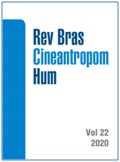Development and reproducibility of an instrument to assess behavioral and environmental aspects related to cyclist safety
DOI:
https://doi.org/10.1590/1980-0037.2020v22e65714Abstract
In urgency and emergency services, the bicycle is the second means of transportation more widely used by the victims at the time of the accident. However, aspects associated with major and minor accidents are poorly understood. The aim was to develop an instrument and test its reproducibility, in order to evaluate behavioral and environmental aspects related to cyclist safety. The instrument was based on footage taken through a camera attached to the cyclist helmet and from a review of literature. Take part in the study academics that used the bicycle to travel at least once a week. Participants were instructed to indicate any safety-critical events on their way and situations of minor gravity based on the perception of real imminence of an accident. In order to identify aspects related to cyclist safety, the routes were divided in periods of 30 seconds. In order to test inter-rater reproducibility, two researchers received theoretical-practical training and performed the instrument in a sample of 100 periods. In order to evaluate the intra-rater reproducibility, one of the evaluators performed a second application after 07 days. The reproducibility of the categorical variables of the instrument were tested through general agreement and Kappa index. For the variables with continuous measuring range, the Intraclass Correlation Coefficient (ICC) was used. The percentage agreement varied between 88-100% and the Kappa values varied between 0.76-1.00. The ICC values ranged from 0.96-0.99. The developed instrument presents adequate reproducibility for use in research to evaluate the cyclist safety in urban contexts.
References
Caixeta CR, Minamisava R, Oliveira LM de AC, Brazil VV. Morbidity due to transportation accidents among young people from Goiânia, Goiás. Cien Saude Colet 2009; 14 (5): 1807-15.
Costa JSD da, Victora CG. What is a public health problem? Rev Bras Epidemiol 2006; 9 (1): 144-51.
Ministries of Health. Datasus [Internet]. Available from: http://tabnet.datasus.gov.br/cgi/tabcgi.exe?sim/cnv/ext10uf.def
Ministry of Health. VIVA: Vigilance of Violence and Accidents: 2013 and 2014. 2017.
Rodrigues CL, Armond JDE, Gorios C, Souza PC. Accidents involving motorcyclists and cyclists in the city of São Paulo: characterization and trends. Rev Bras Ortop 2014; 49 (6): 602-6.
Johnson M, Charlton J, Oxley J, Newstead S. Naturalistic cycling study: identifying risk factors for on-road commuter cyclists. Ann Adv Automot Med 2010;
: 275-83.
Sousa CAM, Bahia CA, Constantino P. Analysis of factors associated with traffic accidents involving cyclists attended in Brazilian capitals. Cien Saude Colet 2016; 21 (12): 3683-90.
Barros AJD, Amaral RL, Oliveira MSB, Lima SC, Gonçalves E V. Traffic accidents with victims: underregistration, characterization and lethality. Cad Saude Publica 2003; 19 (4): 979-86.
Bacchieri G, Barros AJD, Santos JV dos, Gonçalves H, Giant DP. Community intervention to prevent traffic accidents among cyclists. Rev Saude Publica 2010; 44 (5): 867-75.
Hamann CJ, Peek-Asa C. Examination of adult and child bicyclist safety-relevant events using naturalistic bicycling methodology. Accid Anal Prev 2017; 102: 1-11.
Dozza M, Werneke J. Introducing naturalistic cycling data: What factors influence bicyclists’ safety in the real world? Transp Res Part of Traffic Psychol Behav 2014; 24: 83-91.
Vanparijs J, Int Panis L, Meeusen R, De Geus B. Exposure measurement in bicycle safety analysis: A review of the literature. Accid Anal Prev 2015; 84: 9-19.
Terwee CB, Bot SDM, Boer MR, van der Windt DAWM, Knol DL, Dekker J, et al. Quality criteria were proposed for measurement properties of health status questionnaires. J Clin Epidemiol 2007; 60: 34-42.



